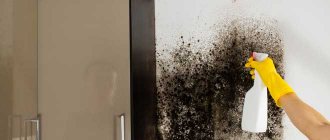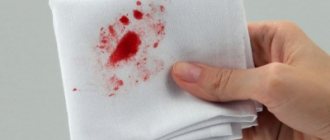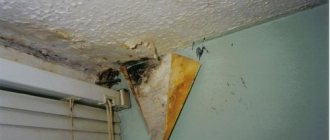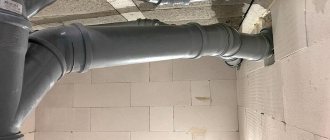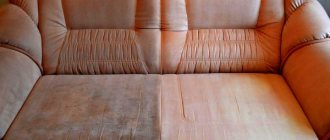An unpleasant musty smell is a signal that there is a source of dampness in the house that needs to be eliminated urgently.
After all, the smell of dampness does not just disturb the comfortable living in the house. In damp conditions, mold and mildew multiply very quickly, causing great harm to human health. We will tell you in this article how to remove the smell of dampness in your home.
Causes of unpleasant odor in the apartment
The main reason for the smell of dampness in the house is high humidity, which can be triggered by the following factors:
Clogged ventilation ducts, lack of fresh air flow. It is especially important to monitor ventilation in the bathroom, where sudden temperature changes and hot water vapor provoke the appearance of condensation on the walls.- Lack of waterproofing of the roof and foundation, freezing of insufficiently insulated building walls. As a result, warm air in the room, coming into contact with cold walls, drops condensation, which leads to increased humidity and an unpleasant smell of dampness.
- Flooding. It doesn’t matter whether the flood in the house was the result of leaking sewer or water pipes, or whether the apartment was flooded by neighbors, it is important to eliminate traces of flooding as quickly as possible so that they do not cause an unpleasant damp smell.
Also, the reasons for the appearance of a musty smell in the house can be:
- drying wet laundry in the room,
- constantly dripping faucets,
- a huge number of flowers in flowerpots (frequent watering provokes increased humidity in the room).
Sewer stench is dangerous
The sewer smell is impossible to get used to. Volatile gases coming from the siphon and pipes spread throughout all areas of the house or apartment. This stench is disgusting and spoils the mood. When guests arrive, the owners of the “fragrant” home have to apologize and make excuses.
Psychological discomfort is far from the worst thing that sewer stench brings with it. What is much worse is that it is dangerous to health. The ability to separate odors into pleasant and unpleasant is a biological mechanism that has ensured the survival of humanity for thousands of years. If the aroma seems unpleasant, it means it is potentially dangerous.
The air from the sewer system is “flavored” with ammonia and hydrogen sulfide. It also contains methane, which has no distinct odor. Volatile gases affect the state of the human nervous system. There may be a feeling of causeless anxiety, nervousness, and irritability.
In a house that smells like sewer, people can become mopey, have breakdowns, have trouble sleeping, and even faint. Long-term exposure to hydrogen sulfide can lead to respiratory diseases: rhinitis, bronchitis.
With a high concentration of gas in the air, poisoning is possible, the symptoms of which are nausea, vomiting, headache, decreased blood pressure and dizziness.
Ammonia negatively affects vision, the respiratory system, causes a state of excitement, and has a general toxic effect. And methane can cause oxygen starvation of cells. Some disturbances in the functioning of the autonomic nervous system cannot be ruled out. For example, a “twitching eye” may well indicate long-term exposure to methane on the body.
At the first sign of a sewer smell in the bathroom or toilet, you should immediately begin to find the cause of the stench and eliminate it. Otherwise, the concentration of gases in the air will only increase, and this can lead to negative consequences for the health of the residents of the house.
What to do first?
The first thing to do if there is a damp smell in the house is to thoroughly ventilate all the rooms . In the autumn-winter period - warm up the air in the rooms (add heating devices).
If airing and warming the air does not help get rid of the unpleasant odor, you should carefully inspect the walls, roof, foundation of the building, as well as the water supply and sewer pipe system for leaks.
Only by eliminating the cause of dampness can you begin to fight its consequences - the musty smell in the house.
How to eliminate it using folk remedies?
Once the cause of the dampness has been eliminated, you can begin to combat the smell of dampness. First of all, they use accessible and safe folk remedies:
Baking soda solution (4 teaspoons of baking soda are dissolved in a liter of warm water). A soft sponge is moistened in the resulting solution and wiped all surfaces in the room (walls, floors, furniture).- Salt and activated carbon . The tablets are ground into powder and mixed with salt (proportion 1:1). The resulting mixture is poured into a glass container, which is left on open cabinet shelves, racks, or simply on the table.
- Pomander is the fruit of an orange, lemon or grapefruit decorated with clove seeds. Little spicy stars are simply pricked onto the citrus fruit in a chaotic manner. Pomander not only perfectly neutralizes the smell of dampness, but also decorates the interior of the room. As the citrus fades, it needs to be replaced.
- Lemon acid . Dissolve 1 tsp in 250 ml of water. citric acid, after which all surfaces in the room are treated with the resulting product.
- Vinegar. It is ignited through a spray bottle onto the floor, walls and furniture. After thirty minutes, wipe the treated surfaces with a soft damp cloth.
After cleaning (especially with the use of strong-smelling compounds), the room must be thoroughly ventilated.
Special preparations
If folk remedies do not help to completely eliminate the unpleasant smell of dampness, re-treatment is carried out using special antiseptic compounds.
Before purchasing, you must make sure that the selected product is suitable for treating internal surfaces and does not contain toxic or caustic substances.
Universal antiseptic Dali
Destroys foci:
- fungus,
- mold,
- moss,
- dampness from any type of surface (brick, plaster, wood, cardboard, ceramic tile).
There is no need to dilute the antiseptic before application. Liquid without color. Economical consumption allows you to treat large areas of affected surfaces. The average cost is 600 rubles. (5 l canister).
Eskaro Biotol Spray
Designed for treating various surfaces in areas of high importance . Biotol spray is effective as a prophylactic agent, as well as as a composition that destroys breeding grounds for mold and moss (sources of damp odors). The average cost is 300 rubles. (500 ml bottle).
Protective composition Belinka
A product that quickly destroys mold and mildew spores and the smell of dampness in the room. Does not contain bleaching components, retains the natural color of treated surfaces.
Before use, the drug is diluted with water (concentration 1:4). The average cost is 350 rubles. (bottle 1 l).
Before applying any chemical composition, you must carefully study the manufacturer's instructions.
How to remove from various surfaces?
In the process of removing the smell of dampness in the house, it is important to pay attention to what materials the sources of the unpleasant odor are made of. For what type of surfaces is there a special approach to cleaning that allows not only to refresh, but also to maintain their original appearance.
Furniture
In order to permanently get rid of the musty smell of dampness from furniture, you must adhere to the following algorithm of actions:
- Place several tablets of activated carbon or sachets of silica gel into a closet emptied of clothes. Salt, tea bags or baking soda placed on the shelves will also help to “pull out” unpleasant odors and moisture from the cabinet.
- Wipe the cabinet walls (on all sides), shelves and crossbars with a rag soaked in a vinegar solution (2 tablespoons per liter of water is enough). After treatment, the cabinet must be left open for several days to allow the slight aroma of vinegar to dissipate.
- If the furniture has been standing in a damp room for a long time, and airing and mowing solution cannot remove the musty smell, a steam generator will come to the rescue. Hot steam treatment will not only refresh, but also disinfect all surfaces.
After the smell of dampness has been removed from the furniture, only cleaned items without foreign odors can be returned to their original place.
Sofas, armchairs
Treating the upholstery with lemon juice or a weak solution of potassium permanganate will help
remove the smell of dampness from upholstered furniture . It is important to test the effect of the solution on an inconspicuous area of the upholstery before cleaning.
Leather sofas or armchairs are wiped with a sponge soaked in a soap solution with the addition of a small amount of ammonia (for one liter of water you need to take 1 teaspoon of ammonia and 50 ml of liquid soap).
After cleaning, leather upholstery should be wiped with a clean damp cloth , then dry with paper towels.
Clothes and other things
The first thing to do is hang things out for airing. Fresh air and sun rays will do their job and there will be no trace of the smell of dampness.
If ventilation does not help and the musty smell does not completely disappear, you can use the following methods:
- fur and knitwear products wrapped in polyethylene are placed in the freezer for twenty-four hours;
- clothes made from natural fabrics (cotton, linen) are ironed at the highest temperature setting. Additionally, perfumed water is poured into the iron;
- clothes made from expensive silk fabrics and wool products are processed using a steamer;
- white items are treated with a cotton swab dipped in a solution of alcohol and ascorbic acid (2-3 tablets per 100 ml of alcohol are enough).
To ensure that clothes never smell damp, they can only be stored in a closet when they are well dried.
Carpets
to eliminate the unpleasant smell of dampness from carpeting :
We use baking soda (the powder not only absorbs unpleasant odors, but also moisture).
The soda is carefully spread over the surface of the carpet in a thin layer and left for at least twelve hours. After using a vacuum cleaner, the soda is collected from the fleecy covering.- A weak solution of vinegar will help clean the carpet not only from the smell of dampness, but also from traces of mold.
Table vinegar is diluted with water (1 tbsp of vinegar is enough for 500 ml of water). The resulting solution is sprayed onto the carpet. After the coating has dried, it is thoroughly cleaned with a vacuum cleaner.
To enhance the cleaning effect, you can add 1 tsp to the vinegar solution. hydrogen peroxide. Before applying any product to the carpet, it should be tested on a small, inconspicuous area.
Features of treating various fabrics against mold
There are many ways to remove mold from fabric. However, each type of material has its own cleaning method.
Leather products may be processed:
- soap solution;
- diluted alcohol;
- vodka;
- water with the addition of ammonia.
You need to treat the affected area with one of the selected products and leave the product for 2 hours.
Cotton clothing can be cleaned using:
- Onions. To do this, you need to treat the stain with vegetable juice and leave for half an hour. After the procedure, wash the item.
- Curdled milk. Soak clothes in it for 12 hours.
- Whiteness. Dilute the bleach with water and soak the clothes in the resulting mixture for 10 minutes.
To process silk and wool products you will need:
- Using a cotton swab, treat the stain with turpentine, and then sprinkle it with clay.
- Rub chalk onto the contaminated area and iron it through a sheet of paper.
Synthetic clothing is treated with a solution made from water and ammonia.
Neutralizing amber in the bathroom
The smell of dampness in the bathroom is a signal that you need to check the operation of the hood . Perhaps the old fan cannot cope and it is necessary to replace it with a more powerful device.
Then you should fix any leaks, wash the dirty laundry accumulated in the basket, and freshen the shower curtains. After all possible causes of unpleasant odor in the bathroom have been diagnosed and eliminated, all surfaces are wiped with water and borax (a glass of borax is enough for 2.5 liters).
How to remove the feeling of dampness left after the flood?
If you still have to make repairs after a flood, then first thoroughly dry the repair area, remove mold and use a primer with antibacterial additives.
If the flooding is not severe, install a dehumidifier or heater, buy an odor absorber at the store, in most cases it is an aerosol spray. Check to see if there is mold under the wallpaper, carpet, linoleum or in other places. Additionally, we recommend drying upholstered furniture, rugs, shoes and clothes.
Prevention measures
You can forever forget about the smell of dampness in your home if you follow the following recommendations:
- Rooms must be ventilated at least twice a day. It is especially important to open windows after wet cleaning and in the kitchen while cooking.
- It is important to monitor the condition of water pipes, sewerage and ventilation in the bathroom. If any problems occur, repairs must be carried out immediately.
- Do not put wet clothes and shoes in the closet. Wet bath towels should be immediately washed or hung on a heated towel rail.
Installing an air conditioner will help maintain a comfortable temperature and humidity and, as a result, forever forget about the smell of dampness in the house.
Fighting damp odors in closets, clothes and shoes
You may have to deal with dampness in your closet for 2-3 days. Let's start with the fact that you must empty the closet of everything that is in it, wash your entire wardrobe and take it out in the sun to dry. Thick clothes should dry for at least 2-3 days, while thin clothes may need even a day. Shoes also need to be washed with strong detergents to completely clean them of any fungal spores that may have gotten inside.
While the clothes are drying, you thoroughly wash the closet, preferably with a disinfectant solution that has an anti-mildew effect. After washing, we take out all the shelves and drawers that you can expose to the sun, and the cabinet itself needs to be perfectly dried. As a recommendation, use a heat fan or an electric battery, but be careful with the battery, do not leave it overnight so as not to cause a fire. When everything is washed and perfectly dry, you can put things back. For prevention, do not forget to put furniture fragrances or bags with fragrant herbs, they remove all remaining odors that cannot be washed and cleaned.
Adviсe
A few secrets will help you get rid of the smell of dampness in your home as quickly as possible:
essential oils added to water for washing floors will not only eliminate the smell of dampness, but also fill the room with pleasant aromas;- By adding a few tablespoons of vinegar to the washing machine along with the washing powder, you can quickly get rid of the unpleasant smell of dampness on your bed linen;
- treating books with tea tree essential oil will help eliminate the unpleasant smell of dampness from paper publications.
The pronounced smell of dampness is the result of damage to surfaces by fungal and mold spores. To prevent pathogenic bacteria from entering the respiratory tract during the cleaning process, the nose and mouth must be protected with a respirator.
You will find a lot of useful and important information about removing various unpleasant odors from objects and surfaces in this section.

